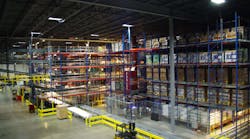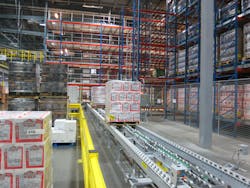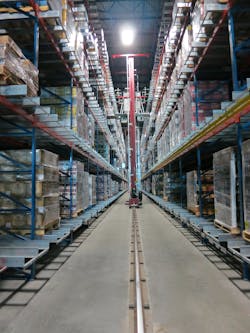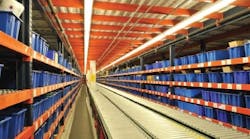Any significant investment in warehousing and distribution technology must have a compelling return on investment. Before the e-commerce era, Automated Storage & Retrieval Systems (AS/RS) were given a lot of attention for their efficient handling of unit loads. Then, when consumers made online ordering a global phenomenon, more attention was given to efficient handling of eaches.
Today, with economic uncertainty affecting many companies’ capital investment plans, AS/RS is getting a fresh look for a variety of economic reasons:
- With a 20-25+ year lifespan, an AS/RS ROI can be achieved in five years or less.
- An AS/RS can store 40% more pallets in the same space as a conventional rack warehouse.
- A single crane operated by three staff members across three shifts can do the same work as nine forklifts and nine employees.
- An AS/RS results in less product damage, and theft is eliminated by “locked” inventory. Further, stretch wrapping costs decrease because less wrap is needed to secure goods on a pallet.
- Forklift leasing and maintenance costs (battery charging station, battery replacement and general cleaning costs) generally exceed normal AS/RS maintenance requirements.
- Especially in refrigerated and frozen warehouses, businesses experience lower energy costs, often on the order of 30% or more. An AS/RS allows businesses to operate using less square footage and in a tighter cube, with smaller ingress/egress openings. Thus, there is less space to cool.
Understanding AS/RS
An AS/RS has five essential components:- A rack system to store product;
- A crane/SRM (storage retrieval machine) that runs on a floor rail;
- A load-handling device/shuttle to move product from the crane to the rack location;
- A conveyor system to move goods to and from the AS/RS and dock areas;
- Warehouse management and material flow control software (WMS, WCS) to control, track and optimize all product movements.
An AS/RS can be installed in an existing facility or designed specifically for a new facility. Most systems can go as high as 130 feet (these are typically rack-supported buildings), and some can be installed in buildings as low as 20 feet (these are generally conventional buildings).
The fact an AS/RS can go higher and be more compact translates into more storage capability within a smaller space. In the instance of building a new warehouse, integrating an AS/RS means the building footprint can be considerably smaller, reducing construction and maintenance costs. For existing facilities, business growth can be accommodated within existing space, avoiding expansion and maintenance costs.
AS/RS Design
Although this article addresses pallet loads, the same technology exists for moving totes, cases, paper rolls, bakery trays and even large car-sized platforms.
System configuration — and the number of aisles needed — depends on product mix and throughput rates. Thus, customer-provided data regarding the number of items/SKUs, product throughput rates and more are critical to AS/RS design. Merely receiving the data is not enough, however. System designers must understand the customer’s data to develop a design that maximizes all the possible technological advantages.Product can be stored in locations/lanes with pallets placed single, double or up to 12 pallets deep. Selecting the correct lane depth and designing the AS/RS to that depth are critical steps in achieving the high throughput rates fast-moving SKUs demand. Lower volume SKUs are typically handled differently, in lane depths suited for their inventory levels.
Today, two cranes/SRMs can be placed in the same aisle, an AS/RS innovation made possible by greater flexibility in controls and Warehouse Management System (WMS) software. So, if anticipated throughput increases are projected over the short term, the addition of a second crane in one aisle can handle them. Plus, the second crane provides redundancy should the other be undergoing routine maintenance.
Modern AS/RS implementations can be flexible hybrid systems. In a hybrid configuration, some lanes are single deep, some are double and some are multiple deep (3 to 12 pallets deep). Thus, AS/RS design can match a client’s item/SKU mix and its varying product throughput rates. An intelligent WMS is the secret to a successful hybrid system, enabling the use of different lane depths and storage of different SKUs. Should the hybrid AS/RS require expansion to meet future growth, aisle lengthening and storage lane extension can be accomplished easily.
Multiple Picking Strategies
An AS/RS can integrate diverse order picking strategies in a variety of ways. It is possible to incorporate pick tunnels within the rack structure to operate with pick-to-light, pick-to-belt and pick-to-voice technologies. In the case of fast-moving products, pallet flow picking lanes can be automatically replenished by the SRM, when guided by a WMS in-sync with the crane/SRM and providing constant updates on current inventory levels. When slower-moving products are involved, they can be organized and replenished in dynamic pick lanes. In this scenario, SKU exchange will be ongoing based on the product requested for picking.
Newer AS/RS designs integrate the crane pick-up and drop-off conveyors within the rack, instead of just at the end of the aisle. This adds accumulation to feed SRMs, as well as reduce the average travel distance of an SRM. Throughput rates per SRM can often increase by 10% to 20% if infeeds/outfeeds are located near the middle of the aisle versus the end.
Note, too, that placing conveyors within the racks allows companies the option of accumulating outbound shipping/receiving orders. This feature can further reduce the costs associated with product handling and crane movements, while improving ergonomics and safety.







